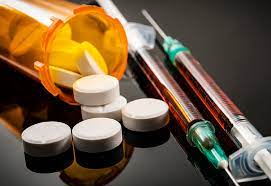People who use opioid medications for a prolonged period usually become desensitized to the drugs’ effects. Eventually, the body will require higher amounts of the drug to experience the same effects it did before. This can be quite harmful and raises the user’s risk of overdosing by accident.
Taking these drugs for extended periods alters how the nerve receptors in the brain function because they start relying on the drug to work. A user who starts feeling sick after they stop using opioid drugs could have developed a physical dependence on these medications. These withdrawal symptoms they experience are the body’s way of physically responding to a lack of drugs.
 Most individuals become dependent on opioids as a way of avoiding withdrawal symptoms or pain. In certain circumstances, they do not even recognize that they have developed physical dependence and might confuse the symptoms for another condition like the flu.
Most individuals become dependent on opioids as a way of avoiding withdrawal symptoms or pain. In certain circumstances, they do not even recognize that they have developed physical dependence and might confuse the symptoms for another condition like the flu.
Opioid withdrawal symptoms are not the same in every user. They will depend on the degree of withdrawal experienced by the person. Other factors will also determine the duration that the user experiences symptoms. Regardless, opioid withdrawal symptoms typically follow a certain timeline as they progress.
Withdrawal can last hours, days, or even weeks depending on the drug taken, the duration of intake, and the amount taken. The person will experience painful and intense symptoms that peak within 72 hours and start to improve after. There should be a noticeable improvement in any severe symptoms within one week.
Diagnosing Opioid Withdrawal
In order to diagnose whether an individual is undergoing opioid withdrawal, a doctor will have to conduct a physical exam and inquire about the symptoms they are experiencing. They might also do a blood test and a urinalysis to see if there are any opioids in the system.
Opioid Withdrawal Treatments and Medication
 Opioid withdrawal is a highly uncomfortable process and most people will keep taking drugs to alleviate the painful symptoms or try to handle the condition by themselves. However, the best chance for success while remaining comfortable throughout the process is to conduct the treatment in a controlled medical environment. Medications can also help recovering users get through opioid withdrawal and deal with the symptoms. Once patients complete the first detox process they are at high risk of using again. According to experts, social and psychological factors are the main reasons for this. Stress and triggering situations can remind the brain how good it felt when using the drug.
Opioid withdrawal is a highly uncomfortable process and most people will keep taking drugs to alleviate the painful symptoms or try to handle the condition by themselves. However, the best chance for success while remaining comfortable throughout the process is to conduct the treatment in a controlled medical environment. Medications can also help recovering users get through opioid withdrawal and deal with the symptoms. Once patients complete the first detox process they are at high risk of using again. According to experts, social and psychological factors are the main reasons for this. Stress and triggering situations can remind the brain how good it felt when using the drug.
The best way to remain abstinent for a long time is through talk therapy or counseling and long-term medication.
Methadone
This drug, also referred to as Methadose or Dolophine, is a long-acting opioid. It acts on the same regions of the brain as the drug the user is abusing but it does not have the same euphoric effect. It can be taken every day but the patient will need to go to a specific clinic to obtain it. Taking the right dosage minimizes drug cravings and keeps withdrawal symptoms at bay.
Buprenorphine
This medication has also been approved for use in opioid dependence treatment. It also acts on similar receptors within the brain as opioids but it is not as powerful. Most medical professionals prefer it because the risk of lethal overdose is much lower. It is also used together with Naloxone and comes in various forms including:
- A 6-month implant that is placed under the skin
- A skin patch
- A film that is placed against the cheek inside the mouth.
- An injection
- Tablets
Users who repeatedly go through opioid withdrawal are meant to be treated using long-term buprenorphine or methadone maintenance.
Naltrexone
This drug works by blocking the opiate receptors located in the brain. It does not relieve drug cravings or withdrawal symptoms like buprenorphine or methadone. However, if you use opioids while on Naltrexone, you will not be able to get high. When administered if opioids are still in the patient’s system, Naltrexone can cause severe and sudden withdrawal.
This medication is ideally used within a comprehensive recovery treatment program. The patient starts taking it after completing the detox treatment. It is effective in preventing relapse. They can take it via injection or orally.
Lofexidine hydrochloride
This drug is used to alleviate the symptoms experienced during rapid detoxification but it is not classified as an opioid. It has been accepted for use for a duration of up to 14 days. It is one of the first non-opioid drugs to be approved by the FDA for the management of opioid withdrawal symptoms. This medication can help to alleviate symptoms for as long as two weeks.
Clonidine
 This drug is used to help patients experiencing opioid withdrawal deal with symptoms such as cramping, runny nose, sweating, muscle aches, agitation, and anxiety. However, it does not decrease the user’s cravings.
This drug is used to help patients experiencing opioid withdrawal deal with symptoms such as cramping, runny nose, sweating, muscle aches, agitation, and anxiety. However, it does not decrease the user’s cravings.
Zubsolv and Suboxone are also used in opioid withdrawal treatment to help prevent relapses in patients. They are both made from a combination of buprenorphine and naltrexone.
As the person is tapering off opioids, they will also be given other non-opioid medications to help ease their withdrawal symptoms. These include:
- Non-steroidal anti-inflammatory drugs (NSAIDs) such as naproxen and ibuprofen.
- Dicyclomine for abdominal pain
- Prochlorperazine for nausea
- Bismuth subsalicylate and loperamide for diarrhea
- Tizanidine for anxiety
Each of the above drugs works in different ways for the treatment of opioid withdrawal. Thus, a qualified healthcare provider should help recovering patients decide on the ideal medication for their treatment based on their unique circumstances and medical history.
